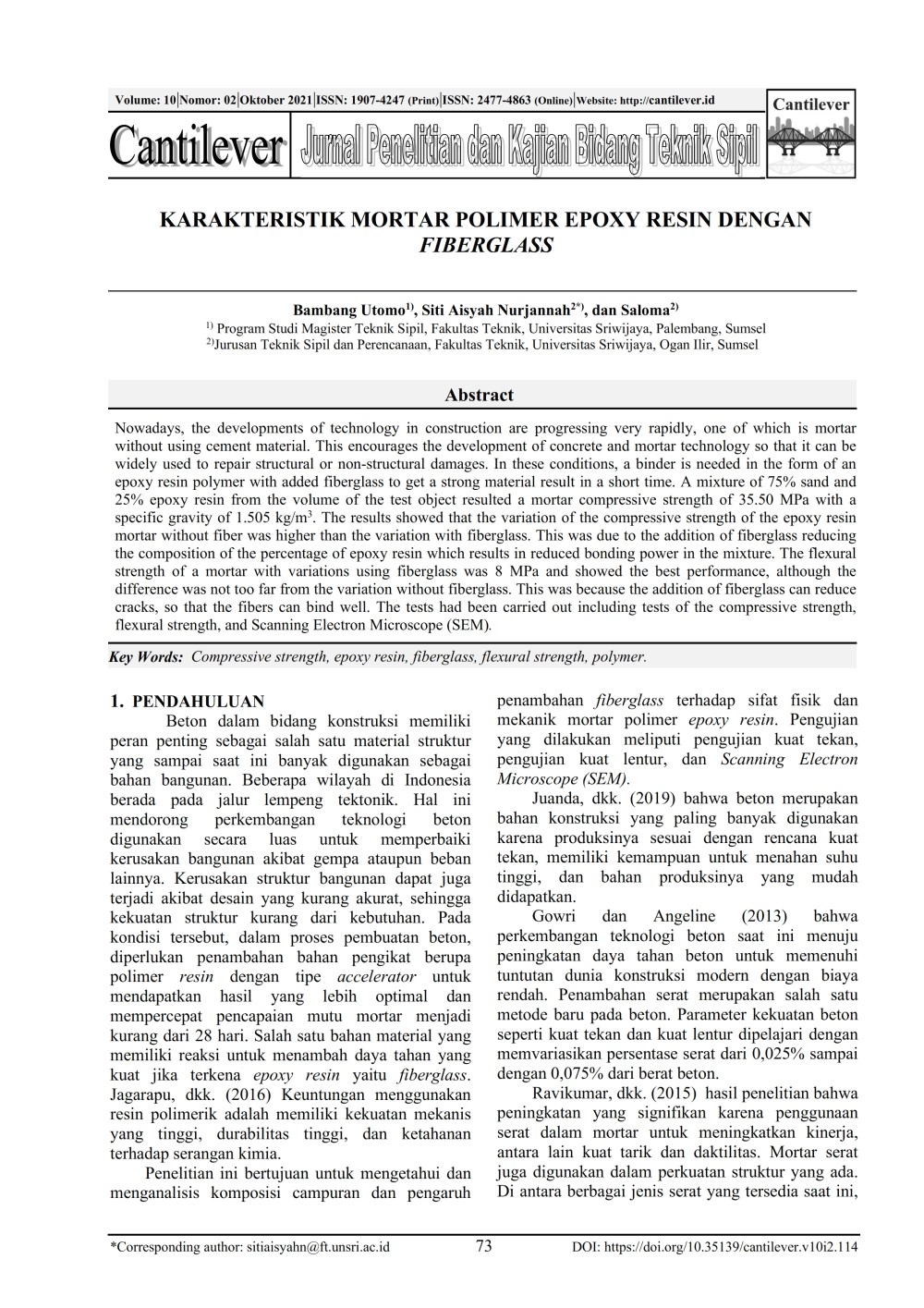Karakteristik Mortar Polimer Epoxy Resin Dengan Fiberglass Characteristics of Epoxy Resin Polymer Mortar With Fiberglass
Main Article Content
Abstract
Nowadays, the developments of technology in construction are progressing very rapidly, one of which is mortar without using cement material. This encourages the development of concrete and mortar technology so that it can be widely used to repair structural or non-structural damages. In these conditions, a binder is needed in the form of an epoxy resin polymer with added fiberglass to get a strong material result in a short time. A mixture of 75% sand and 25% epoxy resin from the volume of the test object resulted a mortar compressive strength of 35.50 MPa with a specific gravity of 1.505 kg/m3. The results showed that the variation of the compressive strength of the epoxy resin mortar without fiber was higher than the variation with fiberglass. This was due to the addition of fiberglass reducing the composition of the percentage of epoxy resin which results in reduced bonding power in the mixture. The flexural strength of a mortar with variations using fiberglass was 8 MPa and showed the best performance, although the difference was not too far from the variation without fiberglass. This was because the addition of fiberglass can reduce cracks, so that the fibers can bind well. The tests had been carried out including tests of the compressive strength, flexural strength, and Scanning Electron Microscope (SEM).
Downloads
Article Details
American Society for Testing and Materials. (2020). ASTM C40 / C40M - 20Standard Test Method for Organic Impurities in Fine Aggregates for Concrete, West Conshohocken, Pennsylvania, United States.
American Society for Testing and Materials.(2015). ASTM ASTM C128 - 15Standard Test Method for Relative Density (Specific Gravity) and Absorption of Fine Aggregate, West Conshohocken, Pennsylvania, United States.
American Society for Testing and Materials. (2019). ASTM C136 / C136M - 19Standard Test Method for Sieve Analysis of Fine and Coarse Aggregates, West Conshohocken, Pennsylvania, United States.
American Society for Testing and Materials.(2017). ASTM C142 / C142M - 17Standard Test Method for Clay Lumps and Friable Particles in Aggregates, West Conshohocken, Pennsylvania, United States.
American Society for Testing and Materials. (2017). ASTM C172 / C172M – 17 Standard Practice for Sampling Freshly Mixed Concrete, West Conshohocken, Pennsylvania, United States.
American Society for Testing and Materials. (2014). ASTM D2419 – 14 Standard Test Method for Sand Equivalent Value of Soils and Fine Aggregate, West Conshohocken, Pennsylvania, United States.
American Society for Testing and Materials.(2019). ASTM C566 - 19Standard Test Method for Total Evaporable Moisture Content of Aggregate by Drying, West Conshohocken, Pennsylvania, United States.
Bowo, A. F., Saloma,Nurjannah,S.A., dan Juliantina, I.,(2020).Sulfate Resistance Of Polymer Light-Weight Concrete with Variation of Epoxy Resin, International Journalof Scientific& Technology Research, Vol. 9 (5), 45-49.
Deshmukh, S. H., Bhusari, J. P., dan Zende, A. M.(2012). Effect of Glass Fibres on Ordinary Portland Cemend Concrete, Journal of Engineering, Vol. 2 (6), 1318-1322.
Gowri, R. dan Angeline, M. M. (2013). Effect of Glass Wool Fibres on Mechanical Properties of Concrete.International Journal of Engineering Trends and Technology, Vol. 4 (7), 2231-538.
Jagarapu, D. C. K., Abhilash, G.V.S., Khasim, K. P., dan Manikanta, S.G. (2016). Experimental Studies on Glass Fiber Concrete, American Journal of Engineering. Vol. 5 (5), 100-104.
Juanda, O., Sagraff, A., Saloma, dan Hanafiah. (2019). Physical and Mechanical Properties of Lightweight Polymer Concrete with Epoxy Resin,International Journalof Scientific& Technology Research,Vol. 8 (7), 857-863.
Kumar, G. B. R. dan Venkatesh, B. (2018). Experimetal Study on Polymer Concrete with Epoxy Resin, International Journal of Pure and Applied Mathematics, Vol. 119 (17), 3129-3138.
Pimplikar, S. S., and Shakor, P. N.(2011).Glass Fiber Reinforced Concrete Composites, International Journal of Technology and Engineering System,Vol. 2 (2), 632-634.
Prema, S., Sakthivel, S., Sankar, C., Kumar, J.V., dan Vijay. S. (2017). Comparative Study on Polymer Resin Concrete, International Journal of ChemTech Research, Vol. 10 (8), 656-661.
Ravikumar, C.S.,Ramasamy, V., dan Thandavamoorthy, T.S. (2015). Effect ofFibers in Concrete, International Journal ofApplied Engineering Research, Vol. 10 (1), 419-430.
Yemam, D. M., Kim, B. J., Moon, J. Y., dan Yi, C., (2017). Mechanical Properties of Epoxy Resin Mortar with Sand Washing Waste as Filler, Materials, Vol. 10 (3), 1003-246.

This work is licensed under a Creative Commons Attribution-NonCommercial 4.0 International License.
Authors who publish with this journal agree to the following terms:
- Authors retain copyright and grant the journal right of first publication with the work simultaneously licensed under a Creative Commons Attribution-NonCommercial 4.0 International License that allows others to share the work with an acknowledgment of the work's authorship and initial publication in this journal.
- Authors are able to enter into separate, additional contractual arrangements for the non-exclusive distribution of the journal's published version of the work (e.g., post it to an institutional repository or publish it in a book), with an acknowledgment of its initial publication in this journal.
- Authors are permitted and encouraged to post their work online (e.g., in institutional repositories or on their website) prior to and during the submission process, as it can lead to productive exchanges, as well as earlier and greater citation of published work (See The Effect of Open Access).
